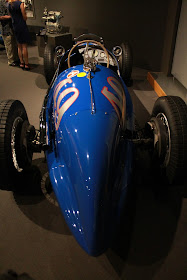Modern consumers may be unaware that before Maserati became an upmarket lifestyle accessory, it was a line of successful racing cars engineered and built on a meager budget. During the period that stretched between the 20th century's two biggest wars, the five Maserati brothers* experimented with such abandon that there were almost as many types of Maserati as there were actual Maserati cars. Among the many engines, there were inline twin-cam fours, sixes and eights, as well as a 4-liter V16 confusingly named the V4. The brothers' long experience finally paid off with something like fame in America when the same Maserati, a sister to the 8CTF below, but owned by the racing team of Mike Boyle, won back-to-back victories at the Indianapolis 500 in 1939 and '40 with American Wilbur Shaw behind the wheel. The background to this achievement also involves an American living in Europe...
A confluence of tides resulted in the Maserati wave that landed at Indy. The GP racing formula was changed from a no-holds-barred 750 kg maximum weight affair to an 850 kg minimum weight after 1937, the same year the Orsi family of successful industrialists bought the Maserati factory and name from the eponymous brothers, signing three of them (Ernesto, Ettore and Bindo) to a ten-year contract under which they provided design and engineering services exclusively to the new firm. Ernesto laid out a new GP car to challenge the Germans in 1938, the same year that former race driver Lucy O'Reilly Schell financed a successful challenge to the German juggernaut at the French GP with Rene Dreyfus leading her semi-official Ecurie Bleue team of Delahaye V12s across the finish line in 1st and 2nd places*. Mrs. Schell soon noticed that the new Maserati was even more powerful than her Delahayes, and bought two of them...
The 8CTF engine design was essentially based upon tandem blocks of the 1.5 liter 4CM Maserati had produced for voiturette racing. The new engine featured a head in unit with the block, or testa fissa (the TF in the model designation), and two valves per cylinder operated by dual overhead cams. Two Roots-type superchargers boosted horsepower to 350 in the first versions, and when this was raised to 365 in final form it was still over 100 hp less than rival Mercedes got with their supercharged V12. Also, the volatile fuels then used in European GPs exposed some fragility in the design...
It would be an understatement to say that the Maserati engine was happier running on the alcohol-based fuel used at Indy. The third 8CTF built, serial number 3032, became the most successful specimen of any car ever to race at the Brickyard. Wilbur Shaw won in 1939 and 1940, and the same car finished 3rd twice and 4th once, running its last race at Indy in 1953. A sister car, the one in these pictures and one of two owned by Schell's team, finished 10th at Indy in the hands of Rene Le Becque and Rene Dreyfus. Dreyfus had been spirited out of France by Schell's Ecurie Blue before the invading Germans could get their hands on him; they were still upset that he had beaten their best at that '38 French GP*.
This car, chassis #3030, the first of only three 8CTF models built, is likely the one in a state closest to its original form. Only one spare engine was originally produced by the factory. Despite that, chassis #3032, the Wilbur Shaw car, enjoyed a 15-year career, an eternity in racing, even in a time of slower technological change. That car is now on display at the Indianapolis Motor Speedway Hall of Fame Museum.
And at the Revs Institute in Naples, Florida, you can get close enough to the first 8CTF to gather some idea of how it might have been to sit in the narrow, form-fitting seat behind the wheel with its distinctive curving spokes drilled for lightness, and face the new challenge of racing on a bumpy, banked oval for 500 miles on your first job assignment as a new immigrant to America. After finishing 10th at Indy, Rene Dreyfus joined the US Army and served in Italy, opening a restaurant called Le Chanteclair in New York City after the war. His bistro was known to provide good food and a congenial environment to talk about cars.
*Footnotes: The Maserati brothers' saga was summarized in "Almost Famous", a post in the archives for 4/20/16, and a story on 4-cylinder 1950s Maserati sports racers appeared in "Before the Birdcage" from 9/30/17. Earlier we recounted the story of Lucy O'Reilly-Schell's racing efforts with Rene Dreyfus in "Dreyfus and the Million-Franc Delahaye" on 11/22/15.
Photo credits:
Top: the author
2nd from top: Ian Avery DeWitt
3rd from top: psychoontyres.co.uk
Balance of photos: Ian Avery-DeWitt






No comments:
Post a Comment